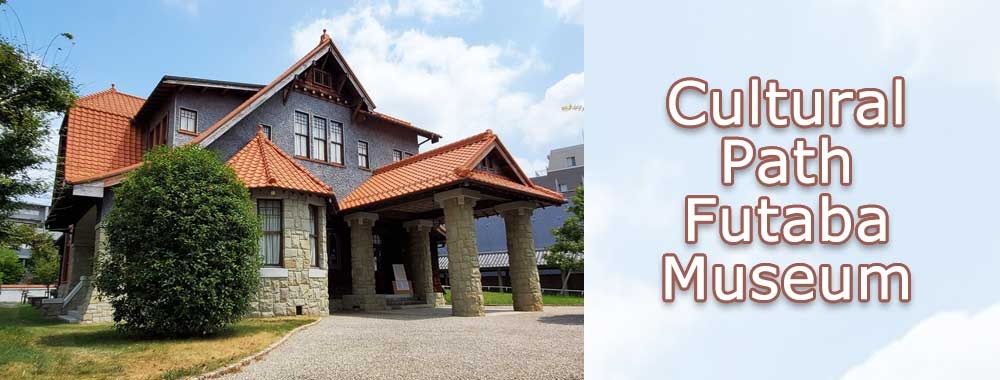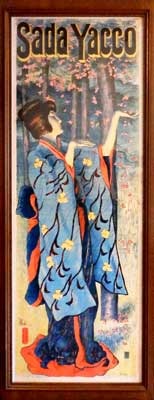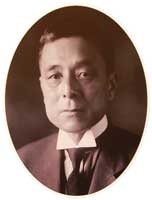2020.09.30

In the Edo period (1603-1868), the area between Nagoya Castle and Tokugawaen was a residential area for middle and lower-class samurai. Through the Meiji (1868-1912), Taisho (1912-1926) and early Showa periods (1926-1989), the district became a stage for the interactions between modern industrial entrepreneurs, missionaries, journalists and other important figures.
Now dubbed the Bunka no Michi (文化のみち) or 'Cultural Path,' the area contains important historical assets including many buildings conveying Nagoya's journey of modernization through the Edo, Meiji and Taisho periods, a precinct for the preservation and utilization of this architectural heritage.
This issue we take a look at one such historical building, the Cultural Path Futaba Museum, a former residence of Kawakami Sadayakko, known as 'Japan's first actress.'
The 'Futaba Palace' 二葉御殿
 After retiring from the stage, Kawakami Sadayakko spent time in Higashifutaba-cho (東二葉町, now Shirakabe / 白壁 2 and 3-chome) in Higashi Ward from 1920 with the 'King of Electric Power,' Fukuzawa Momosuke.
After retiring from the stage, Kawakami Sadayakko spent time in Higashifutaba-cho (東二葉町, now Shirakabe / 白壁 2 and 3-chome) in Higashi Ward from 1920 with the 'King of Electric Power,' Fukuzawa Momosuke.
The opulence of their residence, an eclectic fusion of Japanese and Western styles built on a 6610-square meter property, earned it the moniker of the 'Futaba Palace,' and it became something of a salon for important political, business and cultural figures.
At the time, Fukuzawa, director of the Nagoya Electricity Co., Ltd. (名古屋電燈) had based himself in Nagoya to oversee the development of hydroelectric plants on the Kiso River, and is said to have invited Kawakami to join him as a partner in the project.
The building was designed by up-and-coming residential design firm Amerikaya, and the interior was equipped with electrically-operated features that would have amazed at the time, yet Kawakami's sensibilities are also evident throughout.
Records from the time indicate that guests approached the carriage porch along a circular gravel driveway. Pines and other trees were planted in the grounds, while the grassed garden featured weeping cherry trees and firs, and also seems to have boasted an electric-powered fountain and search lights.
The grand parlor, with its semi-circular sofa, was no doubt bathed in soft light from the stained-glass windows. This was where Kawakami was kept busy organizing refreshments and dinners for the many guests that would visit each day, besides conducting business as the owner of the Kawakami Silk Company.
She would also sometimes accompany Fukuzawa on the three-hour train ride to visit the construction sites of dams along the Kiso River. Busy as their lives were, they lived their lives to the full.
As his health took a turn, Fukuzawa returned to Tokyo, and Kawakami, too, would move back to the capital to instruct at the Kawakami Children's Theatrical Company. The time they spent together in Nagoya was surely a treasured memory for both Kawakami and Fukuzawa.
Work to reconstruct the building at the current location in Shumoku-cho began in February 2000.
The former residence of Kawakami Sadayakko, reborn as the Cultural Path Futaba Museum, opened in February 2005, and was designated a National Cultural Property. The iconic structure with its red-tiled roof is now one of the hubs of the Cultural Path area.
Kawakami Sadayakko
川上貞奴
 Koyama Sada was born in Nihonbashi, Tokyo, in 1871, and adopted by the owner of a geisha house, Hamadaya, in 1878, adding 'Yakko' to her name when she became a geisha in 1887. According to anecdotes, Sadayakko first met Fukuzawa Momosuke (then a student at Keio University) around this time, when he rescued her from a pack of wild dogs.
Koyama Sada was born in Nihonbashi, Tokyo, in 1871, and adopted by the owner of a geisha house, Hamadaya, in 1878, adding 'Yakko' to her name when she became a geisha in 1887. According to anecdotes, Sadayakko first met Fukuzawa Momosuke (then a student at Keio University) around this time, when he rescued her from a pack of wild dogs.
An excellent dancer, beautiful and intelligent, Sadayakko is said to have been the number one geisha in the country, earning the patronage of such figures as prime minister Ito Hirobumi. In 1894 she left the geisha world and married Movement for Civic Rights and Freedom activist, actor and satirist Kawakami Otojiro. She made her debut as the actress Sadayakko (sometimes rendered 'Sada Yacco') when she toured America and Europe with Otojiro's company from April 1899 to January 1901, and again from April 1901 to August 1902.
She made her debut as the actress Sadayakko (sometimes rendered 'Sada Yacco') when she toured America and Europe with Otojiro's company from April 1899 to January 1901, and again from April 1901 to August 1902.
Sadayakko's exotic Japanese dance performances, including performances at the Paris World Exposition, fascinated Western audiences, garnering much acclaim wherever they went, with Madame Sadayakko even receiving an award from the French government. Upon their return to Japan, Sadayakko intended to stay off the stage and return to the role of devoted wife supporting her husband. Urged by Otojiro to assist him in his effort to popularize a new, dialogue-driven drama, Sadayakko decided to ascend the stage in Japan, where actors (even in female roles) had been strictly male. In preparation for the first adaptation of Shakespeare's Othello to be staged in Japan, Sadayakko could be seen doing vocal exercises on the beach at Chigasaki, Kanagawa Prefecture, where they lived at the time. The Kawakami troupe followed up with such productions as The Merchant of Venice and Hamlet, and productions for children, in which Sadayakko once portrayed a violin-playing boy.
The couple embarked on a third tour of Europe in 1907 to observe new theater facilities and actress training methods. The following year they established the Imperial Actress Training School, and in March 1910 another dream was realized with the completion of the Teikokuza theater, replete with cutting-edge facilities, in Osaka. However, Otojiro was to pass away in November of the following year, at the age of 48. The funeral ceremony was held on the stage at the Teikokuza, and crowds of mourners lined the route of the funeral procession.
Sadayakko carried on her husband's work, establishing the Sadayakko Troupe and continuing to perform. Increasingly louder voices, including that of Fukuzawa Momosuke, calling for her to retire led her to step down from the stage in 1917.
In 1918, Sadayakko established the Kawakami Silk Company, Ltd., which produced high-quality silk for export, in Ozone in Nagoya City's Kita Ward.
From around 1920 she moved to Nagoya, living together with her old friend Fukuzawa Momosuke as business partners. Although Sadayakko relocated to Tokyo in 1926, after Fukuzawa also returned to the capital, she maintained a strong connection to the Tokai region. In 1933 she opened a temple built with her own funds, Teishōji (貞照寺), in Unuma, Gifu Prefecture, and built a villa, Banshōen (萬松園), nearby, dividing her time between Tokyo and Unuma.
Kawakami Sadayakko died of liver cancer at her villa in Atami, Shizuoka Prefecture, in 1946. Her grave is located at Teishōji Temple.
Image: Poster "Sada Yacco (Kawakami Sadayakko's Entrance)" replica Alfred Muller, c. 1900
Promotional poster for Sadayakko's performance at the 1900 Paris Exposition
Collection of the Kyoto Institute of Technology Museum and Archives
Fukuzawa Momosuke
福沢桃介
 Born in 1868 as Iwasaki Momosuke, he was regarded as talented from childhood, and would go on to attend Keio University, where his exceptional performance brought him to the attention of the family of Fukuzawa Yukichi (the prominent proponent of reform whose image appears on the 10,000-yen note). Momosuke married Fukuzawa's daughter and became Yukichi's adopted son, taking the Fukuzawa name.
Born in 1868 as Iwasaki Momosuke, he was regarded as talented from childhood, and would go on to attend Keio University, where his exceptional performance brought him to the attention of the family of Fukuzawa Yukichi (the prominent proponent of reform whose image appears on the 10,000-yen note). Momosuke married Fukuzawa's daughter and became Yukichi's adopted son, taking the Fukuzawa name.
In 1913, Momosuke became the chairman of the Nagoya Electric Power Company. Relocating to Nagoya, he embarked on the hydroelectric development of the Kiso River system, and enlisted the cooperation of Kawakami Sadayakko to entertain political and business figures at the 'Futaba Palace' to facilitate the project's progress.
Momosuke oversaw the development of seven power stations on the Kiso River, including the Oi Electric Power Plant, the first dam-type power station in Japan.
Satisfied that the project was on track, in 1926 Momosuke made way for his successors and returned to Tokyo to lead a reclusive life.
He passed away at his home in Shibuya, Tokyo, in 1938. A memorial facility dedicated to Fukuzawa Momosuke is located in Nagiso, Nagano Prefecture.
Further reading: Lesley Downer, Madame Sadayakko: The Geisha who Seduced the West, 2004
Cultural Path Futaba Museum
When: Open 10:00 - 17:00. Closed Mondays (or the following weekday when Monday is a national holiday), 29 Dec. to 3 Jan.
Admission: Adults 200 Yen (Combined admission ticket to Cultural Path Futaba Museum and Cultural Path Shumokukan 320 Yen); Junior HS-aged children and younger free; Other discounts available.
Access: A 10-minute walk north from Takaoka Sta. (高岳駅, S06) Exit 2, Subway Sakura-dori Line (地下鉄桜通線) / A 12-minute walk south from Amagasaka Sta. (尼ケ坂駅, ST04), Meitetsu Seto Line (名鉄瀬戸線) / Nagoya Sightseeing Route Bus Me-guru (なごや観光ルートバス メーグル) Cultural Path Futaba Museum (文化のみち二葉館) stop
Website: https://www.futabakan.jp/




